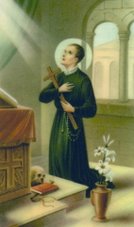 What a jolly feast day! So near to Christmas we are presented with a figure familiar to us all: Santa Claus. But who is he and why do Christians venerate his feast today?
What a jolly feast day! So near to Christmas we are presented with a figure familiar to us all: Santa Claus. But who is he and why do Christians venerate his feast today?St Nicholas was born in Myra in the third century (now modern day Turkey) during the period of persecution by the Roman Empire. St Nicholas was a very holy and humble man, giving up his wealth and becoming a Priest, and later a Bishop. He helped the sick and needy and is celebrated for his compassionate care of families and children. He famously threw bags of gold into one household's window; three bags for as many daughters, so that their poor father could pay the dowry on their marriages.
 He was thrown into prison under the great persecution of Christians, but later released when Rome converted to the Faith. He was present at the Council of Nicaea, and displayed righteous indignation for the Arian heresy by attacking Arius himself. Not so jolly when heresy is concerned, are we Santa? For this he was again, thrown into prison. But an appearance by Our Lord and His Blessed Mother quickly helped to re-establish his office of Bishop.
He was thrown into prison under the great persecution of Christians, but later released when Rome converted to the Faith. He was present at the Council of Nicaea, and displayed righteous indignation for the Arian heresy by attacking Arius himself. Not so jolly when heresy is concerned, are we Santa? For this he was again, thrown into prison. But an appearance by Our Lord and His Blessed Mother quickly helped to re-establish his office of Bishop.There are many legends and stories attached to his life, of miraculous protection and generosity. One occasion which particularly demonstrates his affection for the young, concern three theological students travelling on their way to Athens. They were cruelly captured and murdered by a wicked innkeeper, and kept in a vat of pickling water. St Nicholas later happened to stay at this very inn, and in the night had a terribly vivid dream depicting these three young men being killed. Awaking from this apparition, he called for the innkeeper to come at once, and fell on his knees in prayer. Whilst he begged God's mercy and compassion, the three boys miraculously came back to life. It is not known how St Nicholas then took care of the innkeeper!
 Even long after his death (6th December 343), St Nicholas' intercession has been attributed to many miracles. He even appeared to a young slave boy and rescued him from his evil Arab master, returning him to his parents in the Saint's home town of Myra, who were desperate for his return. There are also many stories about his assistance with people at sea, and for this reason many seaports have chapels that are named after him. For more on the 'historical' Nicholas, see here.
Even long after his death (6th December 343), St Nicholas' intercession has been attributed to many miracles. He even appeared to a young slave boy and rescued him from his evil Arab master, returning him to his parents in the Saint's home town of Myra, who were desperate for his return. There are also many stories about his assistance with people at sea, and for this reason many seaports have chapels that are named after him. For more on the 'historical' Nicholas, see here.He is the Patron of children, mariners, sailors, scholars, orphans, labourers, paupers, maidens, innocent captives, even murderers! Although his tomb was in Myra, his relics were rescued away to Bali in Italy, which became a great centre of pilgrimage. He is celebrated among Europeans with acts of generosity, like the giving of gifts. In Germany and Poland, boys dressed up as bishops and begged for alms for the poor. Dutch children leave hay and carrots in their shoes for the saint's horse, hoping they will be exchanged for gifts!
 All these things can help us understand where the cult of Santa Claus comes from. I think that by celebrating this feast day early on in advent, it keeps the focus on Christ as the centre of Christmas Day, rather than anticipating imaginary visits from sleighs and reindeer on Christmas eve (however fun that may be)!
All these things can help us understand where the cult of Santa Claus comes from. I think that by celebrating this feast day early on in advent, it keeps the focus on Christ as the centre of Christmas Day, rather than anticipating imaginary visits from sleighs and reindeer on Christmas eve (however fun that may be)!So I decided this morning, to wake up the little one by donning a Santa costume and gave sacks of presents to go under our Christmas tree. Of course, they will only be opened when the Nativity comes, and serve as a sign within our family of the love we share.

















No comments:
Post a Comment